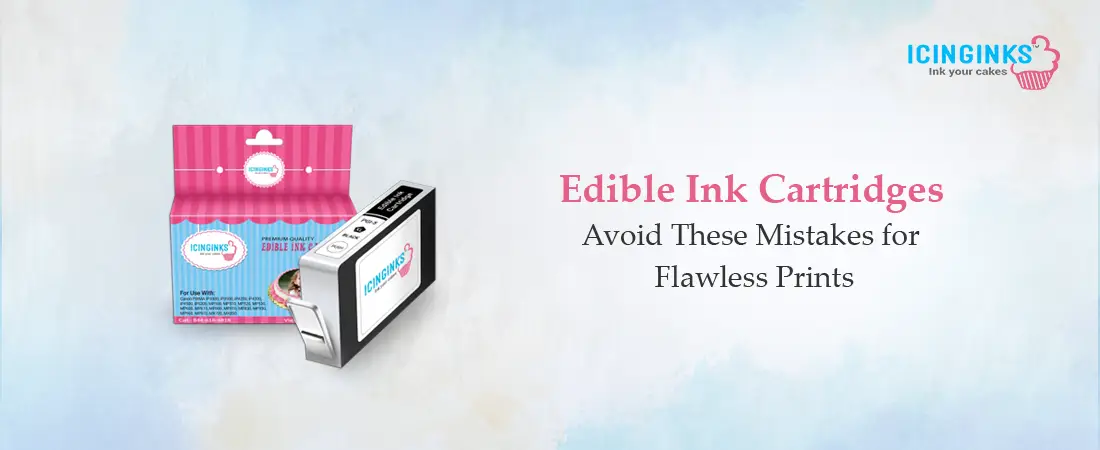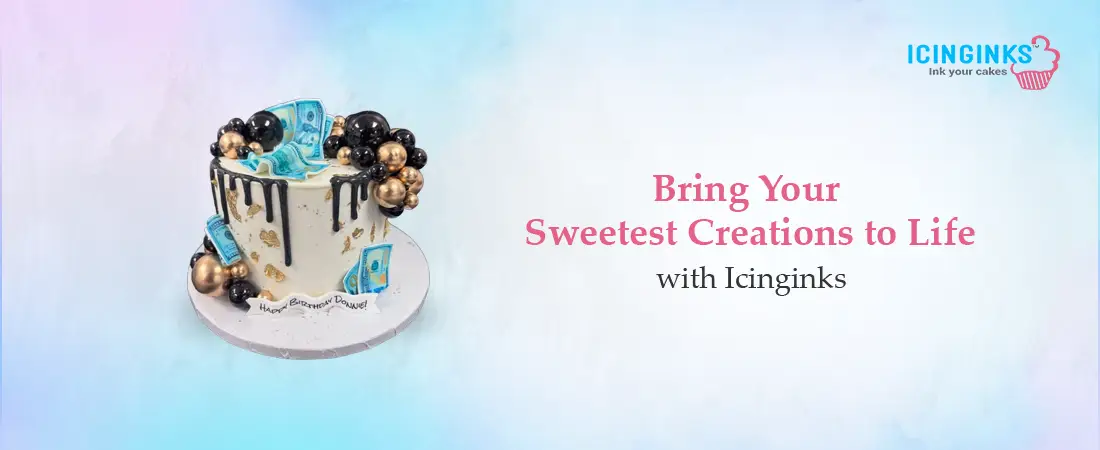
Printing on cakes, cookies, and cupcakes has never been easier, thanks to edible ink cartridges. They allow bakers, confectioners, and hobbyists to create stunning, professional-quality designs on edible surfaces. However, many users face issues like clogging, poor print quality, and wastage, often due to simple mistakes. Understanding these common errors and how to prevent them can save time, money, and frustration. In this guide, we'll explore people's most frequent mistakes when using edible ink cartridges and provide expert tips to ensure smooth and high-quality printing.
1. Using Non-Compatible Edible Ink Cartridges
One of the biggest mistakes users make is purchasing non-compatible ink cartridges for their edible printer. Not all cartridges work with every model, and using the wrong ones can result in poor print quality or even damage to the printer.
How to Avoid It:
- Always check the printer’s manual for compatible cartridge models.
- Purchase edible ink cartridges from reputable brands that specify compatibility with your printer.
- Avoid using standard printer ink, as it is toxic and unsafe for food use.
2. Failing to Clean the Edible Printer Regularly
Edible ink differs from standard ink—it can dry out quickly and clog the printer’s nozzles if not properly maintained. Skipping regular cleaning can lead to uneven prints or complete blockages.
How to Avoid It:
- Clean the printhead at least once a week, even if you are not using the printer frequently.
- Run the printer’s built-in cleaning cycle to remove dried ink from the nozzles.
- Use a cleaning solution designed for edible ink cartridges if the ink dries.
3. Improper Storage of Edible Ink Cartridges
Exposure to heat, air, and direct sunlight can cause edible ink to dry out or change in consistency, affecting the print quality. Many users unknowingly store their cartridges incorrectly, leading to wasted ink.
How to Avoid It:
- Store edible ink cartridges in a cool, dry place away from direct sunlight.
- Keep them sealed in their original packaging until ready for use.
- Shake the cartridges gently before installation to mix the ink properly.
4. Ignoring Paper Type and Quality
Using the wrong type of edible paper, such as wafer paper or icing sheets, can cause smudging, poor color payoff, or printer jams. Some people use low-quality edible sheets that don't absorb the ink properly.
How to Avoid It:
- Use high-quality icing sheets or wafer paper designed for edible printing.
- Make sure the sheets are dry and free from moisture before printing.
- Adjust the printer settings to match the paper type for optimal results.
5. Not Allowing the Print to Dry Properly
Many users handle printed edible sheets too soon, causing smudging or ink transfer. Edible ink takes a few minutes to set, especially on icing sheets.
How to Avoid It:
- Let printed sheets air-dry for at least 10-15 minutes before handling.
- Place the sheets in a cool, dry area and avoid touching the inked surface.
- If necessary, use a fan to speed up the drying process.
6. Forgetting to Use the Printer Regularly
Edible ink printers need regular use to keep the ink flowing smoothly. If left unused for weeks, the ink can dry up inside the printhead, causing blockages that are difficult to clean.
How to Avoid It:
- Print a small test image every few days to keep the ink flowing.
- If you don’t need to print frequently, remove and seal the cartridges properly until the next use.
- Perform a nozzle check before printing important designs to ensure even ink distribution.
7. Overfilling or Mishandling Refillable Cartridges
Some users prefer refillable edible ink cartridges, but overfilling them or using low-quality ink can lead to leaks, print defects, or damage to the printer.
How to Avoid It:
- Follow the manufacturer’s guidelines when refilling edible ink cartridges.
- Avoid overfilling to prevent leaks and uneven printing.
- Always use high-quality, food-grade edible ink from trusted suppliers.
8. Using Expired or Low-Quality Edible Ink
Edible ink has a shelf life; expired ink can affect color vibrancy and taste. Some users also buy cheap, low-quality ink that produces dull prints and may not be food-safe.
How to Avoid It:
- Check the expiration date before installing edible ink cartridges.
- Buy ink from reputable brands that adhere to food safety standards.
- Store ink properly to maintain its consistency and quality.
9. Printing at the Wrong Resolution or Color Settings
Many users don’t adjust their printer settings before printing, leading to blurry or faded edible images. The wrong resolution or color profile can ruin the design.
How to Avoid It:
- Set the printer to high-resolution mode for detailed images.
- Check the color settings to ensure vibrant and accurate prints.
- Do a test print on regular paper before using expensive edible sheets.
10. Not Handling the Printer with Care
Edible printers are delicate devices that require proper handling. Rough usage, improper cartridge installation, or frequent paper jams can reduce their lifespan.
How to Avoid It:
- Install and remove edible ink cartridges carefully, following the instructions.
- Avoid forcing paper into the printer—always load it gently.
- Regularly check for dust or crumbs inside the printer and clean it properly.
Conclusion: Get the Best Results from Your Edible Ink Cartridges
Avoiding these common mistakes will help you achieve vibrant, professional-quality edible prints while extending the life of your edible printer. You can easily create stunning edible designs by using the right ink cartridges, maintaining your printer, and following best practices.
Ready to print perfect edible images? Start by choosing high-quality edible ink cartridges and giving your printer the care it deserves!
Transform Your Confections with Icinginks' Premium Edible Printing Solutions

At Icinginks, we specialize in providing top-tier edible ink cartridges and edible printers designed to bring your creative visions to life. Our edible ink cartridges are crafted to deliver vibrant, high-quality images, ensuring your cakes, cookies, and pastries are as stunning as they are delicious.
Our range of edible printers is compatible with various edible papers, including icing sheets, sugar sheets, frosting sheets, and wafer paper, offering you the flexibility to create intricate designs easily.
Choose Icinginks for your edible printing needs and experience the perfect blend of quality, safety, and innovation. Let us help you make every creation a masterpiece.
FAQs
1. Why is my edible printer not printing properly with Edible Ink Cartridges?
The nozzles may be clogged if your edible printer isn’t printing correctly. Regularly clean the printhead and use high-quality Edible Ink Cartridges to prevent blockages. Also, ensure you use compatible cartridges and the correct printer settings for vibrant, smudge-free edible prints.
2. How can I prevent Edible Ink Cartridges from drying out?
Store Edible Ink Cartridges in a cool, airtight container when not in use. Print regularly to keep the ink flowing and run a nozzle check if the printer sits idle for too long. Keeping the printer’s printhead clean also helps prevent ink from drying up.
3. What type of paper should I use with Edible Ink Cartridges?
Edible Ink Cartridges work best with high-quality frosting sheets, wafer paper, or chocolate transfer sheets. Using non-edible paper can damage your printer and affect print quality. Always check compatibility with your edible printer and ensure the paper is food-safe and moisture-resistant.
4. Why are my edible prints faded or blurry?
Faded or blurry prints can result from low-quality ink, improper printer settings, or old cartridges. Use premium Edible Ink Cartridges, select the highest print quality settings, and ensure your frosting sheets or wafer paper are dry and moisture-free before printing.
5. Can I refill my Edible Ink Cartridges?
Refilling edible ink cartridges is possible, but it’s not recommended unless using high-quality, food-safe ink. Incorrect refilling can introduce air bubbles, clog nozzles, or contaminate the ink. For the best results, replace your cartridges with fresh, manufacturer-approved ones.
6. How do I clean my edible printer’s printhead?
To clean the printhead, run the printer’s built-in cleaning cycle. Remove the printhead and rinse it with warm distilled water for deep cleaning. Let it dry completely before reinstalling. Regular maintenance prevents ink buildup and ensures smooth printing with Edible Ink Cartridges.
7. How long do Edible Ink Cartridges last?
Edible Ink Cartridges typically last 6-12 months, depending on usage and storage. Always check the expiration date and store them properly to maintain ink quality. Avoid exposing them to heat or direct sunlight to prevent drying or color degradation.
Related Post:
How Refillable Edible Cartridges Trim Costs and Reduce Waste in Printing
Why Using Edible Ink Cleaning Cartridges at Regular Intervals is Must
Unlock Vibrant Edible Designs: Decorate Cakes & More with Edible Ink Cartridges!




